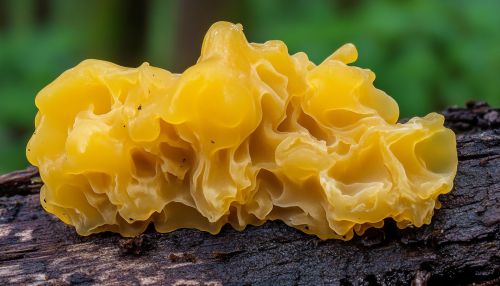Tremella mesenterica
Introduction
Tremella mesenterica, commonly known as the yellow brain, golden jelly fungus, or witch's butter, is a species of fungus in the family Tremellaceae. This jelly fungus is widely distributed and can be found on dead deciduous wood, particularly oak and beech. It is known for its distinctive gelatinous, bright yellow to orange fruiting bodies that resemble a brain or scrambled eggs.
Taxonomy and Etymology
The species was first described by Carl Linnaeus in 1753 as Tremella mesenterica in his seminal work Species Plantarum. The genus name Tremella is derived from the Latin word for "trembling" or "shaking," referring to the gelatinous nature of the fruiting body. The species epithet mesenterica comes from the Greek word for "middle intestine," reflecting the convoluted appearance of the fungus.
Morphology
The fruiting body of Tremella mesenterica is gelatinous, lobed, and brain-like, typically measuring 2–7 cm across. It is bright yellow to orange in color and becomes paler with age or when dried. The surface is smooth and shiny, and the texture is soft and rubbery. The fungus lacks a distinct stem, attaching directly to the substrate.


Habitat and Distribution
Tremella mesenterica is saprobic, meaning it feeds on dead organic matter. It is commonly found on dead deciduous wood, particularly oak, beech, and other hardwoods. The fungus is widespread, occurring in temperate and subtropical regions across the globe, including North America, Europe, Asia, and Australia.
Life Cycle and Reproduction
Tremella mesenterica exhibits a complex life cycle involving both sexual and asexual reproduction. The sexual phase involves the formation of basidia, specialized cells where meiosis occurs, producing basidiospores. These spores are dispersed by wind and germinate to form haploid mycelia. When compatible mycelia meet, they fuse to form a dikaryotic mycelium, which eventually produces the characteristic fruiting body.
In addition to sexual reproduction, Tremella mesenterica can reproduce asexually through the production of conidiospores. These spores are produced on specialized structures called conidiophores and can germinate to form new mycelia without the need for sexual fusion.
Ecological Role
As a saprobic organism, Tremella mesenterica plays a crucial role in the decomposition of dead wood, contributing to nutrient cycling in forest ecosystems. It is also known to parasitize other fungi, particularly species in the genus Peniophora. By parasitizing these fungi, Tremella mesenterica indirectly influences the composition and dynamics of fungal communities on decaying wood.
Chemical Composition and Bioactivity
Tremella mesenterica contains a variety of bioactive compounds, including polysaccharides, terpenoids, and sterols. The polysaccharides, in particular, have been studied for their potential immunomodulatory and antioxidant properties. Research has shown that extracts from Tremella mesenterica can enhance immune function, reduce oxidative stress, and exhibit anti-inflammatory effects. These properties make the fungus a subject of interest for potential therapeutic applications.
Culinary and Medicinal Uses
While Tremella mesenterica is not commonly consumed as a food, it is sometimes used in traditional medicine, particularly in East Asia. The fungus is believed to have health-promoting properties, including boosting the immune system, improving skin health, and supporting overall vitality. However, it is important to note that scientific evidence supporting these claims is limited, and further research is needed to fully understand the medicinal potential of Tremella mesenterica.
Similar Species
Tremella mesenterica can be confused with other jelly fungi, particularly those in the genus Dacrymyces. One notable look-alike is Dacrymyces chrysospermus, which also produces yellow, gelatinous fruiting bodies. However, Dacrymyces species typically grow on coniferous wood and have different microscopic characteristics, such as the presence of tuning fork-shaped basidia.
Conservation Status
Tremella mesenterica is not currently considered to be at risk of extinction and is classified as "Least Concern" by the International Union for Conservation of Nature (IUCN). Its widespread distribution and ability to thrive in a variety of habitats contribute to its stable population status.
Research and Future Directions
Ongoing research on Tremella mesenterica focuses on its ecological role, chemical composition, and potential medicinal applications. Scientists are particularly interested in the bioactive compounds produced by the fungus and their potential health benefits. Future studies may explore the mechanisms underlying the immunomodulatory and antioxidant effects of Tremella mesenterica polysaccharides, as well as their potential use in pharmaceuticals and nutraceuticals.
